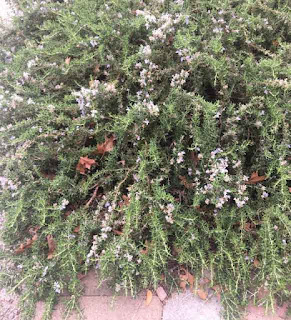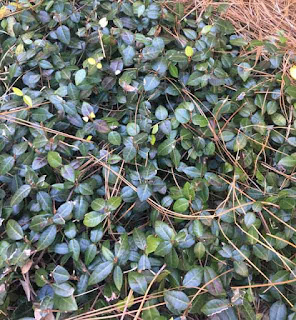A stroll on Hilton Head Island reveals a short list

Coastal landscapes are very demanding on plants. Strong sunlight,
wind, sandy soil, and salt air require much. A recent stroll at Sea
Pines, Hilton Head provided a short list of species that thrive in
such conditions, at least in the Deep South.
Here’s what I
found:
 |
| Nerium oleander flowers and leaves |
Usually known only as "oleander", its origins are unknown, though the Mediterranean region is likely. Nerium is usually grown in tropical and subtropical environments as a free-form shrub. It blooms all summer long. Flowers in colors ranging from white to red are fragrant. Variegated foliage is available. Maintenance requirements are extremely low.
 |
| Creeping Fig - Ficus pumila |
Creeping Fig is an elegant vine that does it's job gracefully,
producing a luxuriant, evergreen covering where it is needed. Perhaps
you have seen Creeping Fig covering garden walls in lovely cities of
the Deep South. Clinging closely, it lends dark green softness to all
kinds of structures.
 |
| Cycas revoluta - Sago Palm |
Cycas revoluta - aka Sago Palm - is not a palm at all, but a member of the ancient Cycadaceae family. It's native to Japan, and is comfortable in warm temperate and subtropical regions. Sago is popular throughout the South, in botanical gardens and landscapes.
 |
| Asparagus densiflorus 'Myersii' - Asparagus fern |
This member of the
Asparagaceae family is not a fern, but an asparagus. It's hardy in USDA climate zones 9-11. While often used as a container plant, it also does well in the landscape, provided that it's protected during freezing weather. Though this particular plant was photographed in the sun, I've found that it has better color if grown in partial shade.
 |
| Salvia rosmarinus 'Prostratus' aka Rosemary |
As taxonomists would have it, Rosmarinus is now classified as a Salvia. But whatever. It's a fine plant for the coastal garden. Its Latin name is even derived from its native habitat meaning "dew of the sea." Rosemary is native to the Mediterranean region. Some varieties are susceptible to frost, but it thrives in heat and well-drained soil. Beside its ornamental use, rosemary is well-known for its culinary value.
 |
| Gelsemium sempervirens - Carolina Jessamine |
As I write this in mid-March, this gorgeous garland of yellow is in full bloom. Its range is from Virginia to Texas and southward through Mexico.
Carolina Jessamine is one of my favorite flowering vines. It can be grown high or low, over your mailbox or under it. The deep yellow garlands in the trees drop lovely blossoms on the forest floor below, golden mantles drape garden walls, and the fragrance is wonderful.
 |
| Cyrtomium falcatum - Holly Fern |
This glossy, evergreen beauty is tough as nails. Its beauty is irresistible. Use if for ground cover, borders, accents. Gardeners in colder climates can grow it as a house plant.
 |
| Aspidistra elatior - Cast-Iron Plant |
True to its name, Aspidistra is beyond tough. As I wrote in an earlier
article, "In dry, thin soil under trees they thrive. Stuffed in neglected pots, they wait for someone to come and dribble a little water; often just a styrofoam cup of melted ice and lemon slice. Yellowed by too much sun, ragged from neglect, they persist. Often they are as neglected indoors, or worse." But when grown in shade with a bit of care, Aspidistra lends a wonderful tropical appearance to the home and landscape.
 |
| Nephrolepis cordifolia - Erect Sword Fern |
Several species go by the common name of Sword Fern. Best go by the botanical name if you're looking for this one. Nephrolepis cordifolia is a very successful evergreen ground cover fern for southern and coastal gardens. So successful, in fact, that some folks consider it to be invasive. But, hey, it covers ground. Isn't that what ground covers are supposed to do?
 |
| Nandina domestica - Heavenly Bamboo |
Nandina is a rather common landscape shrub that's hardy from UDSA Climate Zone 6 through 11. It's native to Japan. Evergreen foliage often turns to scarlet shades in winter, and new foliage may be burgundy in color. Berries are usually red, though other colors appear on the market. Dwarf forms are available. It's about as easy to grow as anything you can imagine. Fairly fertile soil and a little water is all it needs. Grow it in full sun or partial shade.
 |
| Dianella tasmanica - Flax Lily |
Dianella is a fairly new plant on the market. It might be named for the Greek goddess, Diana, or another Diane. I don't know. At any rate, it's native to Tasmania and southeastern Australia. Its small, blue flowers are quite charming. The variegated form is my favorite. Dianella is evergreen, thrives in sun or partial shade, dry soil, and warmer climate zones - specifically USDA Climate zones 9 through 11.
 |
| Hedera algeriensis - Algerian ivy |
Algerian Ivy, also known as Hedera algeriensis, Hedera canariensis, Hedera canariensis var. algeriensis, Algerian Ivy, Canary Island Ivy, North African Ivy, or Madeira Ivy is a favorite of gardeners in the South. It thrives in warmer climates. Large, glossy, evergreen leaves cover ground nicely. It's not limited to use as a ground cover, however. It will easily cover fences, balustrades, and trellises, too. Deer won't eat it. Algerian Ivy is salt tolerant and drought tolerant, too.
 |
| Asiatic Jasmine |
Asiatic Jasmine (
Trachelospermum asiaticum) vines form a dense, glossy, evergreen mat, that suppresses weeds, making it an ideal ground cover. It thrives in full sun to full shade in USDA climate zones 7 to 9, and tolerates a wide variety of soil types. It's drought tolerant, deer and rabbit resistant. It's a ground cover that you're bound to love.
This is by no means an exhaustive list of appropriate plants for the coastal garden, but I figure it's about all that the normal adult's attention span will tolerate. I'll probably post an additional list in the future.



















1 comment:
grat post
Post a Comment